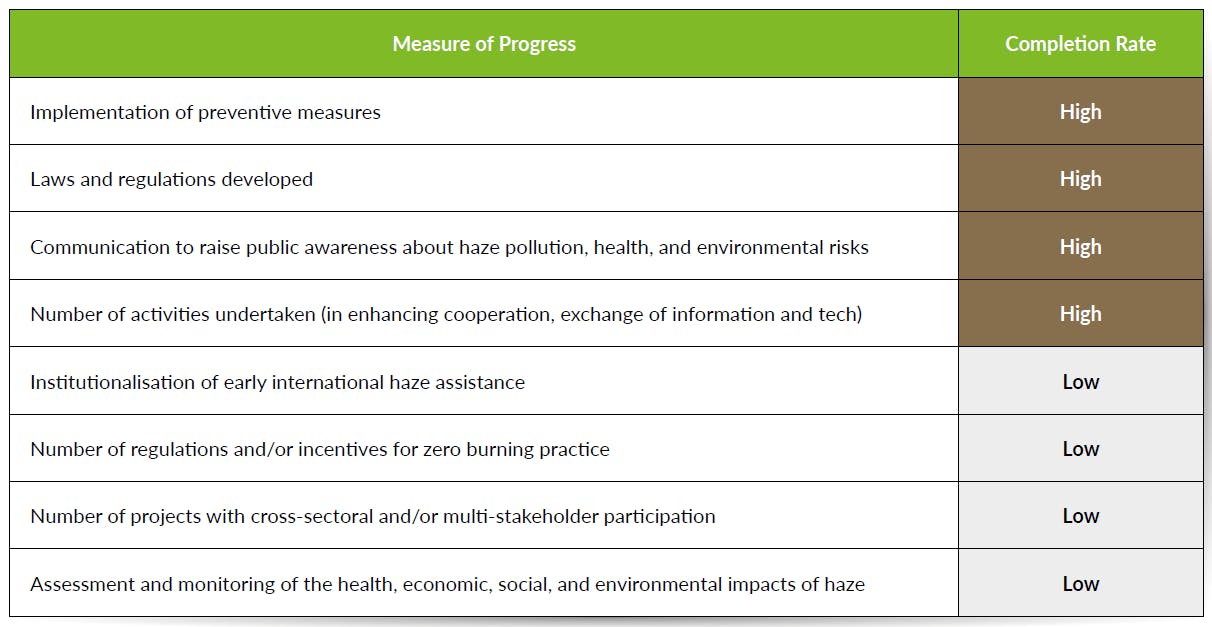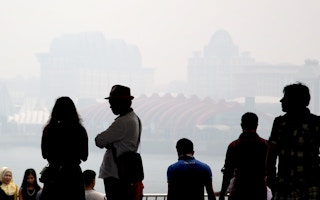The probability of a severe transboundary haze affecting Southeast Asian countries is high this year, according to a new report by the think tank Singapore Institute of International Affairs (SIIA).
To continue reading, subscribe to Eco‑Business.
There's something for everyone. We offer a range of subscription plans.
- Access our stories and receive our Insights Weekly newsletter with the free EB Member plan.
- Unlock unlimited access to our content and archive with EB Circle.
- Publish your content with EB Premium.
The institute issued its first-ever red or high risk rating since it began publishing an annual Haze Outlook report five years ago, primarily due to the hotter and drier weather expected in the coming months in the event of a strong El Niño and positive Indian Ocean Dipole (IOD).
El Niño refers to the unusual warming of the ocean surface in the central and eastern tropical Pacific Ocean, while positive IOD events – often associated with El Niño – are characterised by warmer sea surface temperatures in the western Indian Ocean relative to the east. The risk of haze is assessed on a scale of green (low risk), amber (medium risk), and red.
While concerning, the latest report cautioned against diminishing the improvements made by Indonesia and Malaysia over the past few years in strengthening law enforcement and implementing fire prevention and suppression policies. According to the report, the seriousness of both countries in combatting the threat of fires and haze in recent years means that a weaker El Niño and IOD would lower the risk rating from red to amber, as existing initiatives would be effective in keeping fires and haze in check.
A stress test for Asean’s cooperation
With regard to Association of Southeast Asian Nations (Asean)‘s recent transboundary talks, the report also pointed out that there were “some low-hanging fruit” that countries could cooperate on under the new haze-free roadmap. Members of the regional bloc, for example, can come to a consensus on uniform air quality indicators in the region and foster greater cooperation with private sector stakeholders on land management.
“We hope that the cooperation efforts built up over the years can endure what looks like quite a severe situation,” Simon Tay, chairman of SIIA, told Eco-Business at the media briefing for the report on Wednesday (21 June).
Earlier this month, Asean leaders met in Singapore to discuss to discuss how to collaborate more closely to combat cross-border haze. The Asean Secretariat commissioned an independent review of the previous roadmap that was published last June, which Asean leaders are using as a basis for discussion. Areas that scored low progress include the institutionalisation of early international assistance, regulations or incentives for zero burning, and working with the private sector.

Areas that scored high and low progress in the independent review of Asean’s first-haze free roadmap (2016-2020), where scoring was given on a scale of very low, low, moderate, high, and very high. Source: Singapore Institute of International Affairs, summarised from “Executive Summary of the Final Review of the Roadmap on ASEAN Cooperation towards Transboundary Haze Pollution Control with Means of Implementation”
“They did identify the need for… multi-stakeholder partnerships as something that needs improve going forward. So I think we would see some of that being operationalised in the new roadmap,” said SIIA senior assistant director of special projects and sustainability Aaron Choo, who co-authored the report.
The report cites predictions from the United States National Ocean and Atmospheric Administration (NOAA) that there is an 84 per cent chance of an El Niño will a greater than moderate strength and a one in four chance of a “super El Niño”, where ocean surface temperatures rise two degrees Celsius above the long-term average. This suggests a strong likelihood that 2024 will surpass 2016 as the world’s hottest year.
The 2015-2016 El Niño tied with the 1997-1998 event as the strongest El Niño on record, and both events coincided with severe haze episodes.
“What we are saying today should not alarm Indonesia, they alarmed us first. They called for the alarm way back at the start of the year,” said Tay.
Earlier this February, Indonesian President Joko Widodo threatened to remove police chiefs from their posts if they did not do enough to prevent forest fires during the upcoming dry season – a promise he previously made in 2016 and reiterated in 2018. A month before, Indonesia’s environment and forestry minister Siti Nurbaya Bakar similarly warned that stern action would be taken against companies found to have caused forest fires in the country.
In Malaysia, the minister of natural resources, environment and climate change Nik Nazmi has placed emphasis on preventing illegal open burning as early as this April, in preparation for the hotter and drier conditions in the months ahead. On the back of the Asean leaders’ meeting in Singapore, Nazmi mentioned that the ministry is in talks with the country’s stock exchange Bursa Malaysia to get its plantation firms in Indonesia to formally disclose forest fire measures. He also mentioned that Malaysia is still mulling the introduction of a law to punish local companies that burn Indonesian plantations and cause haze in Malaysia.
“They have done the right thing to call the alarm early. We just hope they will continue to carry on this way,” Tay told the media. “The weather is going to be a real stress test… what Indonesia and Malaysia have built up should not be underestimated, but the pressure is going to grow.”
Experts that Eco-Business spoke to previously had also called for the implementation of domestic laws and stronger enforcement mechanisms to hold polluters responsible. They say that Asean countries still lack potent laws for cross-border haze management, in large part due to the “Asean way”, where disputes are managed in a non-confrontational way by honouring national sovereignty and non-interference of other member states.
Incentivising sustainable and fire-free production
Historically, price spikes in agricultural commodities have been subsequently followed by increased deforestation in Southeast Asia as growers hastily clear land in response to global demand. However, the region has managed to break this correlation in recent years. Even as prices rised in previous years, deforestation has continued to decline. The price surge in 2022 – which triggered an amber alert in last year’s Haze Outlook report – did not lead to haze, in part due to Indonesia’s price controls which helped ease domestic palm oil prices.
Therefore, while there is concern that presently elevated palm oil prices relative to historical multi-year averages might increase the risk of deforestation and haze, especially given some evidence that planting and replanting is on the rise, the report noted that these higher prices are not detrimental in and of themselves.
“Ideally palm oil and other commodity prices should be high enough to support livelihoods, but not so high that they instead incentivise unsustainable and illegal expansion,” the report said.
The growth of nature-based carbon projects in the region as well as burgeoning carbon markets, such as in Indonesia and Malaysia, could support forest conservation efforts, the report mentioned. Among the Asean countries, only Singapore has imposed a carbon tax. Singapore is also where the global spot trading exchange Climate Impact-X – which aims to set a benchmark price for nature-based carbon credits – is headquartered. But other member states like Indonesia, Malaysia, and Vietnam, have announced plans to enact their own carbon pricing mechanisms.
Unlike agricultural commodity prices, prices of nature-based carbon offsets on the major spot carbon exchange CBL have dipped by over 76 per cent since the start of the year.
“Much of it depends on the carbon price for Asean, whether it’s profitable to generate carbon credits from forests. vis-à-vis using the same land for plantation commodities. It has to make business sense,” said Choo. “While the global price for voluntary market isn’t the best, the signal will still be to the big companies that this is a potential revenue earner in the future.”
Regarding the European Union (EU) deforestation law that was adopted this month, Tay said the EU as well as Indonesia and Malaysia recognise that both issues, preventing deforestation as well as protecting livelihoods, are important. The EU regulation, which bans the imports of products like coffee, palm oil, soya, and rubber linked to deforestation, has previously been called discriminatory by the governments of Indonesia and Malaysia, which together account for about 85 per cent of global palm oil exports.
Tay says that in substance, there “should be no strong disagreement” as dialogues continue between the EU and Indonesia and Malaysia during the 18-month implementation period of the regulation, given that Indonesia has been working to stop deforestation and has brought down its deforestation rate to the lowest in 20 years as of 2022.
The report argued that if producers in Indonesia and Malaysia can meet the EU’s new standards, they could “firmly secure EU market access and prove to international consumers that palm oil and other agricultural exports from Asean are indeed sustainable.”
“
The haze, once it breaks out this year, will literally make it hazy to see what the real issues are.
Simon Tay, chairman, SIIA
But Tay warned that that the severe haze, if it happens, could complicate progress. “If you’re sitting in Europe and you see forest fires, you’re going to believe that this is a sign of deliberate deforestation. It’s very easy to start pointing out all these sectors to say, how can you say with [a degree of due diligence] that these companies in Indonesia and Malaysia did not cause deforestation… when they are exporting crops?”










